Effect of Artificial Aging on Mechanical and Tribological Properties of CAD/CAM Composite Materials Used in Dentistry
Abstract
:1. Introduction
- Cases of major prosthetic and orthodontic-prosthetic rehabilitation. Here, a thorough diagnosis preceded by taking diagnostic impressions and determining the therapeutic position is necessary. The therapeutic position determines the mutual positioning of the teeth to stabilize the mandibular alignment in all planes. This requires long-term use of temporary crowns or onlays (with or without tooth preparation) to reprogram the masticatory muscles and adapt the temporomandibular joint to its new normal position. These can be cemented permanently or used as removable restorations such as bite splints worn around the clock or for a required number of hours. This type of restoration is also used in the treatment of MLD (mandibular lateral displacement/deviation), in the repositioning of the TMJ disc, in the treatment of asymmetrical or symmetrical compressions and distractions of the temporomandibular joint.
- Cases of immediate loading of implants. By making temporary crowns for the entire dental arch before the removal of old teeth, it is possible to prepare temporary crowns using the CAD/CAM method even before implantation on the basis of photographs and the patient’s smile design. Temporary crowns can be immediately screwed on and are used in this form for at least 5–9 months. After a period of healing, they are replaced with the final restoration using the immediate implant bridge.
- Cases of patients who undergo gingivectomy (gum resection). In these cases, temporary crowns or veneers should be used for a period of 2–4 months until the shape of the gums stabilizes, before the final dental restoration is performed.
- Cases of patients who receive dental implants followed by individualized gum emergence and shaping profile using individual shapes generated in software and screwed to the implant for 1–9 months.
2. Materials and Test Method
2.1. Materials
2.2. Sample Preparation and Aging
2.3. Indentation Hardness Measurements
2.4. Sliding Wear
2.5. Statistical Analysis
3. Results
3.1. Indentation Hardness, Stiffness and Elasticity
3.2. Elastic Deformation to Failure H2/E
3.3. Indentation Hardness Repeatability—Weibull Analysis
3.4. Analysis of Elasticity Changes
3.5. Results of Sliding Wear Tests
3.6. Analysis of the Effect of Material Hardness on Tribological Properties
4. Discussion
4.1. Indentation Properties
4.2. Friction and Abrasive Wear
5. Conclusions
Author Contributions
Funding
Institutional Review Board Statement
Informed Consent Statement
Data Availability Statement
Conflicts of Interest
Appendix A
| Group vs. Group | T | Z | p-Level |
|---|---|---|---|
| M I & M I AS | 0.000000 | 4.372373 | 0.000012 |
| M II & M II AS | 0.000000 | 4.372373 | 0.000012 |
| M III & M III AS | 0.000000 | 4.372373 | 0.000012 |
| M V & M V AS | 2.000000 | 4.318559 | 0.000016 |
| M VI & M VI AS | 0.000000 | 4.372373 | 0.000012 |
| Group vs. Group | T | Z | p-Level |
|---|---|---|---|
| M I & M I AS | 0.0000 | 4.372373 | 0.000012 |
| M II & M II AS | 0.0000 | 4.372373 | 0.000012 |
| M III & M III AS | 0.0000 | 4.372373 | 0.000012 |
| M V & M V AS | 0.0000 | 4.372373 | 0.000012 |
| M VI & M VI AS | 0.0000 | 4.372373 | 0.000012 |
| Group vs. Group | T | Z | p-Level |
|---|---|---|---|
| M I & M I AS | 9.00000 | 1.885695 | 0.059337 |
| M II & M II AS | 0.00000 | 2.803060 | 0.005062 |
| M III & M III AS | 0.00000 | 2.803060 | 0.005062 |
| M V & M V AS | 13.00000 | 1.477977 | 0.139415 |
| M VI & M VI AS | 0.00000 | 2.803060 | 0.005062 |
References
- Burke, F.J.; Murray, M.C.; Shortall, A.C. Trends in indirect dentistry: 6. Provisional restorations, more than just a temporary. Dent. Update. 2005, 32, 443–444, 447–448, 450–452. [Google Scholar] [CrossRef]
- Mizrahi, B. Temporary restorations: The key to success. Br. Dent. J. 2019, 226, 761–768. [Google Scholar] [CrossRef]
- Spear, F. An interdisciplinary approach to the use of long-term temporary restorations. J. Am. Dent Assoc. 2009, 140, 1418–1424. [Google Scholar] [CrossRef] [PubMed]
- Piedra-Cascón, W.; Krishnamurthy, V.R.; Att, W.; Revilla-León, M. 3D printing parameters, supporting structures, slicing, and post-processing procedures of vat-polymerization additive manufacturing technologies: A narrative review. J. Dent. 2021, 109, 103630. [Google Scholar] [CrossRef] [PubMed]
- ISO 17296-2:2015. Additive Manufacturing General Principles Part 2: Overview of Process Categories and Feedstock; International Standards Organization: Geneva, Switzerland, 2015. [Google Scholar]
- Bagheri, A.; Jin, J. Photopolymerization in 3D printing. ACS Appl. Polym. Mater. 2019, 1, 593–611. [Google Scholar] [CrossRef] [Green Version]
- Burke, F.T.; Sands, P. Use of a novel resin composite crown as a long-term provisional. Dent. Update 2009, 36, 481–487. [Google Scholar] [CrossRef] [PubMed]
- Górski, F.; Wichniarek, R.; Kuczko, W.; Burdzińska, M.; Jankowska, M. Mechanical properties of parts of medical components produced using additive manufacturing technologies. Adv. Sci. Technol. Res. J. 2017, 11, 166–171. [Google Scholar] [CrossRef] [Green Version]
- Żukowska, M.; Górski, F.; Wichniarek, R.; Kuczko, W. Methodology of low cost rapid manufacturing of anatomical models with material imitation of soft tissues. Adv. Sci. Technol. Res. J. 2019, 13, 12–128. [Google Scholar] [CrossRef]
- Barone, S.; Neri, P.; Paoli, A.; Razionale, A.V.; Tamburrino, F. Development of a DLP 3D printer for orthodontic applications. Procedia Manuf. 2019, 38, 1017–1025. [Google Scholar] [CrossRef]
- Radosh, A.; Kuczko, W.; Wichniarek, R.; Górski, F. Prototyping of cosmetic prosthesis of upper limb using additive manufacturing technologies. Adv. Sci. Technol. Res. J. 2017, 11, 102–108. [Google Scholar] [CrossRef] [Green Version]
- Kuzmanovic Pficer, J.; Dodic, S.; Lazic, V.; Trajkovic, G.; Milic, N.; Milicic, B. Occlusal stabilization splint for patients with temporomandibular disorders: Meta-analysis of short and long term effects. PLoS ONE 2017, 12, e0171296. [Google Scholar] [CrossRef] [PubMed]
- Tahayeri, A.; Morgan, M.; Fugolin, A.P.; Bompolaki, D.; Athirasala, A.; Pfeifer, C.S.; Bertassoni, L.E. 3D printed versus conventionally cured provisional crown and bridge dental materials. Dent. Mater. 2018, 34, 192–200. [Google Scholar] [CrossRef] [PubMed]
- Ferracane, J.L. Hygroscopic and hydrolytic effects in dental polymer networks. Dent. Mater. 2006, 22, 211–222. [Google Scholar] [CrossRef]
- Finer, Y.; Santerre, J.P. The influence of resin chemistry on a dental composite’s biodegradation. J. Biomed. Mater. Res. Part A Off. J. Soc. Biomater. Jpn. Soc. Mater. Aust. Soc. Biomater. Korean Soc. Biomater. 2004, 69, 233–246. [Google Scholar] [CrossRef] [PubMed]
- Ammar-Khodja, I.; Picard, C.; Fois, M.; Marais, C.; Netchitaïlo, P. Preliminary results on thermo-oxidative ageing of multi-hole carbon/epoxy composites. Compos. Sci. Technol. 2009, 69, 1427–1431. [Google Scholar] [CrossRef]
- Sobków, D.; Barton, J.; Czaja, K.; Sudoł, M.; Mazoń, B. Badania odporności materiałów na działanie czynników środowiska naturalnego. Chemik 2014, 68, 347–354. [Google Scholar]
- Romil, S.; Kumar, A.S.; Kumar, A.S.; Saurabh, G.; Praveen, G.; Siddhi, T. An evaluation of flexural strength of different provisional restorative materials-an in-vitro study. Ind. J. Dent. Sci. 2012, 4, 17–19. [Google Scholar]
- Stawarczyk, B.; Liebermann, A.; Eichberger, M.; Güth, J.-F. Evaluation of mechanical and optical behavior of current esthetic dental restorative CAD/CAM composites. J. Mech. Behav. Biomed. Mater. 2015, 55, 1–11. [Google Scholar] [CrossRef]
- Heintze, S.D.; Rousson, V. Clinical effectiveness of direct class II restorations a meta-analysis. J. Adhes. Dent. 2012, 14, 407–431. [Google Scholar] [PubMed]
- Bayne, S.C. Correlation of clinical performance with ‘in vitro tests’ of restorative dental materials that use polymer-based matrices. Dent. Mater. 2012, 28, 52–71. [Google Scholar] [CrossRef] [PubMed]
- Scribante, A.; Vallittu, P.; Lassila, L.V.J.; Viola, A.; Tessera, P.; Gandini, P.; Sfondrini, M.F. Effect of Long-Term Brushing on Deflection, Maximum Load, and Wear of Stainless Steel Wires and Conventional and Spot Bonded Fiber-Reinforced Composites. Int. J. Mol. Sci. 2019, 20, 6043. [Google Scholar] [CrossRef] [Green Version]
- Lewis, R.; Dwyer-Joyce, R.S. Wear of human teeth: A tribological perspective. Proc. Inst. Mech. Eng. J. J. Eng. Tribol. 2005, 219, 1–18. [Google Scholar] [CrossRef] [Green Version]
- Zhou, Z.R.; Yu, H.Y.; Zheng, J.; Qian, L.M.; Yan, Y. Friction and Wear Behavior of Human Teeth. In Dental Biotribology; Springer: New York, NY, USA, 2013. [Google Scholar] [CrossRef] [Green Version]
- Ayatollahi, M.R.; Yahy, M.Y.; Karimzadeh, A.; Nikkhooyifar, M.; Ayo, A. Effects of temperature change and beverage on mechanical and tribological properties of dental restorative composites. Mater. Sci. Eng. 2015, 54, 69–75. [Google Scholar] [CrossRef]
- Berg, I.C.H.; Rutland, M.W.; Arnebrant, T. Lubricating properties of the initial salivary pellicle—an AFM study. Biofouling 2003, 19, 365–369. [Google Scholar] [CrossRef]
- Leyland, A.; Matthews, A. On the significance of the H/E ratio in wear control: A nanocomposite coating approach to optimised tribological behaviour. Wear 2000, 246, 1–11. [Google Scholar] [CrossRef]
- Yang, L.J. Wear coefficient equation for aluminium-based matrix composites against steel disc. Wear 2003, 255, 579–592. [Google Scholar] [CrossRef]
- Agarwal, G.; Patnaik, A.; Sharma, R.K. Parametric Optimization and Three-Body Abrasive Wear Behavior of Sic Filled Chopped Glass Fiber Reinforced Epoxy Composites. Int. J. Compos. Mater. 2013, 3, 32–38. [Google Scholar]
- Wesemann, C.; Spies, B.C.; Sterzenbach, G.; Beuer, F.; Kohal, R.; Wemken, G.; Pieralli, S. Polymers for conventional, sub-tractive, and additive manufacturing of occlusal devices differ in hardness and flexural properties but not in wear re-sistance. Dent. Mater. 2021, 37, 432–442. [Google Scholar] [CrossRef] [PubMed]
- Available online: https://www.pro3dure.com/media/pdf/73/9d/56/GR-17-1-temporary-lt_Gebrauchsanweisung-D-EN-ES-FR-IT.pdf (accessed on 20 June 2021).
- ISO 10271:2020. Dentistry—Corrosion Test Methods for Metallic Materials; International Standards Organization: Geneva, Switzerland, 2020. [Google Scholar]
- Oliver, W.C.; Pharr, G.M. Measurement of hardness and elastic modulus by instrumented indentation: Advances in understanding and refinements to methodology. J. Mater. Res. 2004, 19, 3–20. [Google Scholar] [CrossRef]
- Hardiman, M.; Vaughan, T.J.; McCarthy, C.T. The effects of pile-up, viscoelasticity and hydrostatic stress on polymer matrix nanoindentation. Polym. Test. 2016, 52, 157–166. [Google Scholar] [CrossRef] [Green Version]
- Sneddon, I.N. The relation between load and penetration in the axisymmetric Boussinesq problem for a punch of arbitrary profile. Int. J. Eng. Sci. 1965, 3, 47–57. [Google Scholar] [CrossRef]
- Ilie, N.; Bucuta, S.; Draenert, M. Bulk-fill resin-based composites: An in vitro assessment of their mechanical performance. Oper. Dent. 2013, 38, 618–625. [Google Scholar] [CrossRef]
- Safety Data Sheet according to Regulation (EC) No. 1907/2006 (REACH). Available online: https://www.pro3dure.com/media/pdf/ed/df/f5/printodent-GR-17-1-temporary-lt_05_19-GB.pdf (accessed on 12 July 2021).
- Safety Data Sheet according to Regulation (EC) No. 1907/2006 (REACH). Available online: https://www.pro3dure.com/media/pdf/19/a4/5d/printodent-GR-10-guide_51_20-GB.pdf (accessed on 12 July 2021).
- Safety Data Sheet according to Regulation (EC) No. 1907/2006 (REACH). Available online: https://www.pro3dure.com/media/pdf/7c/f9/d5/printodent-GR-17-temporary_05_19-GB.pdf (accessed on 12 July 2021).
- NextDent SG (Surgical Guide). Available online: https://nextdent.com/products/sg-surgical-guide/ (accessed on 12 July 2021).
- NextDent C & B MFH (Micro Filled Hybrid). Available online: https://nextdent.com/products/cb-mfh-micro-filled-hybrid (accessed on 12 July 2021).
- Walczak, A.; Pieniak, D.; Niewczas, A.; Niewczas, A.M.; Kordos, P. Study of ceramic-polymer composites reliability based on the bending strength test. J. KONBiN 2015, 35, 169. [Google Scholar] [CrossRef] [Green Version]
- Danzer, R. On the relationship between ceramic strength and the requirements for mechanical design. J. Eur. Ceram. Soc. 2014, 34, 3435–3460. [Google Scholar] [CrossRef]
- Niewczas, A.M.; Pieniak, D.; Ogrodnik, P. Reliability analysis of strength of dental composites subjected to different photopolymerization procedures. Eksploat. Niezawodn. Maint. Reliab. 2012, 14, 249–255. [Google Scholar]
- Walczak, A.; Pieniak, D.; Niewczas, A.M.; Gil, L. Laboratory studies of the influence of thermal cycling on anti-wear properties of composites used in biotribological friction pairs. Tribologia. 2018, 4, 143–149. [Google Scholar] [CrossRef]
- Łepicka, M.; Grądzka-Dahlke, M.; Pieniak, D.; Pasierbiewicz, K.; Niewczas, A. Effect of mechanical properties of substrate and coating on wear performance of TiN-or DLC-coated 316LVM stainless steel. Wear 2017, 382, 62–70. [Google Scholar] [CrossRef]
- Łępicka, M.; Grądzka-Dahlke, M.; Pieniak, D.; Pasierbiewicz, K.; Kryńska, K.; Niewczas, A. Tribological performance of titanium nitride coatings: A comparative study on TiN-coated stainless steel and titanium alloy. Wear 2019, 422, 68–80. [Google Scholar] [CrossRef]
- Hwang, W.; Han, K.S. Fatigue of composites—fatigue modulus concept and life prediction. J. Compos. Mater. 1986, 20, 154–165. [Google Scholar] [CrossRef]
- Kamimura, K. Modélisation théorique de la croissance d’endommagement appliquée à la théorie des plaques stratifiées. J. Mécanique Théorique Et Appliquée 1985, 4, 537–553. [Google Scholar]
- Ashby, M.F.; Shercliff, H.; Cebon, D. Materials: Engineering, Science, Processing and Design; Butterworth-Heinemann: Oxford, UK, 2018. [Google Scholar]
- Borrero-Lopez, O.; Guiberteau, F.; Zhang, Y.; Lawn, B.R. Wear of ceramic-based dental materials. J. Mech. Behav. Biomed. Mater. 2019, 92, 144–151. [Google Scholar] [CrossRef]
- Hutchings, I.; Shipway, P. Tribology: Friction and Wear of Engineering Materials; Butterworth-Heinemann: Oxford, UK, 2017. [Google Scholar]
- Goh, G.D.; Agarwala, S.; Goh, G.L.; Dikshit, V.; Sing, S.L.; Yeong, W.Y. Additive manufacturing in unmanned aerial vehicles (UAVs): Challenges and potential. Aerosp. Sci. Technol. 2017, 63, 140–151. [Google Scholar] [CrossRef]
- Parker, G. Encyclopedia of Materials: Science and Technology; Elsevier: Amsterdam, The Netherlands, 2001. [Google Scholar]
- Ochelski, S. Metody Doświadczalne Mechaniki Kompozytów Konstrukcyjnych (Experimental Methods of Mechanics of Structural Composites); WNT: Warszawa, Poland, 2004. [Google Scholar]
- Imielińska, K.; Wojtyra, R. Wpływ absorpcji wody na właściwości laminatów winyloestrowych wzmocnionych włóknem aramidowym i szklanym. Kompoz. (Compost.) 2003, 3, 192–197. [Google Scholar]
- Janda, R.; Roulet, J.F.; Latta, M.; Rüttermann, S. Water sorption and solubility of contemporary resin-based filling materials. J. Biomed. Mater. Res. Part B Appl. Biomater. Off. J. Soc. Biomater. Jpn. Soc. Biomater. Aust. Soc. Biomater. Korean Soc. Biomater. 2007, 82, 545–551. [Google Scholar] [CrossRef] [PubMed]
- Väyrynen, V.O.; Tanner, J.; Vallittu, P.K. The anisotropicity of the flexural properties of an occlusal device material processed by stereolithography. J. Prosthet. Dent. 2016, 116, 811–817. [Google Scholar] [CrossRef]
- Pieniak, D.; Niewczas, A.; Walczak, A.; Łępicka, M.; Grądzka-Dahlke, M.; Maciejewski, R.; Kordos, P. The effect of thermal stresses on the functional properties of various dental composites. Tribol. Int. 2020, 152, 106509. [Google Scholar] [CrossRef]
- Pieniak, D.; Walczak, A.; Walczak, M.; Przystupa, K.; Niewczas, A.M. Hardness and wear resistance of dental biomedical nanomaterials in a humid environment with non-stationary temperatures. Materials 2020, 13, 1255. [Google Scholar] [CrossRef] [PubMed] [Green Version]
- Rayyan, M.M.; Aboushelib, M.; Sayed, N.M.; Ibrahim, A.; Jimbo, R. Comparison of interim restorations fabricated by CAD/CAM with those fabricated manually. J. Prosthet. Dent. 2015, 114, 414–419. [Google Scholar] [CrossRef]
- Berli, C.; Thieringer, F.M.; Sharma, N.; Müller, J.A.; Dedem, P.; Fischer, J.; Rohr, N. Comparing the mechanical properties of pressed, milled, and 3D-printed resins for occlusal devices. J. Prosthet. Dent. 2020, 124, 780–786. [Google Scholar] [CrossRef]
- Reymus, M.; Stawarczyk, B. In vitro study on the influence of postpolymerization and aging on the Martens parameters of 3D-printed occlusal devices. J. Prosthet. Dent. 2012, 125, 817–823. [Google Scholar] [CrossRef]
- Drummond, J.L.; Lin, L.; Al-Turki, L.A.; Hurley, R.K. Fatigue behaviour of dental composite materials. J. Dent. 2009, 37, 321–330. [Google Scholar] [CrossRef] [PubMed]
- Takeshige, F.; Kawakami, Y.; Hayashi, M.; Ebisu, S. Fatigue behavior of resin composites in aqueous environments. Dent. Mater. 2007, 23, 893–899. [Google Scholar] [CrossRef] [PubMed]
- Mayworm, C.D.; Camargo, S.S., Jr.; Bastian, F.L. Influence of artificial saliva on abrasive wear and microhardness of dental composites filled with nanoparticles. J. Dent. 2008, 36, 703–710. [Google Scholar] [CrossRef] [PubMed]
- Mehl, C.; Scheibner, S.; Ludwig, K.; Kern, M. Wear of composite resin veneering materials and enamel in a chewing simulator. Dent. Mater. 2007, 23, 1382–1389. [Google Scholar] [CrossRef] [PubMed]
- Ozimina, D.; Ryniewicz, A. Eksploatacja Systemów Tribologicznych. T. 1, Znaczenie Tribologii w Eksploatacji Obiektów Technicznych (red. Ozimina, D.); Wydawnictwo Politechniki Świętokrzyskiej w Kielcach: Kielce, Poland, 2013. [Google Scholar]
- Yilmaz, E.Ç.; Sadeler, R. A Literature Review on Chewing Simulation and Wear Mechanisms of Dental Biomaterials. J. Bio. Tribo Corros. 2021, 7, 1–10. [Google Scholar] [CrossRef]
- Rodríguez, H.A.; Kriven, W.M.; Casanova, H. Development of mechanical properties in dental resin composite: Effect of filler size and filler aggregation state. Mater. Sci. Eng. C 2019, 101, 274–282. [Google Scholar] [CrossRef]
- Lambrechts, P.; Goovaerts, K.; Bharadwaj, D.; De Munck, J.; Bergmans, L.; Peumans, M.; Van Meerbeek, B. Degradation of tooth structure and restorative materials: A review. Wear 2006, 261, 980–986. [Google Scholar] [CrossRef]
- Claude, A.; Robin, O.; Gehin, C.; Massot, B. Design and evaluation of a novel technology for ambulatory monitoring of bruxism events. Sens. Actuators A Phys. 2019, 295, 532–540. [Google Scholar] [CrossRef] [Green Version]
- Rosar, J.V.; de Souza Barbosa, T.; Dias, I.O.V.; Kobayashi, F.Y.; Costa, Y.M.; Gavião, M.B.D.; Castelo, P.M. Effect of interocclusal appliance on bite force, sleep quality, salivary cortisol levels and signs and symptoms of temporomandibular dysfunction in adults with sleep bruxism. Arch. Oral Biol. 2017, 82, 62–70. [Google Scholar] [CrossRef] [PubMed]
- Jain, V.; Mathur, V.P.; Abhishek, K.; Kothari, M. Effect of occlusal splint therapy on maximum bite force in individuals with moderate to severe attrition of teeth. J. Prosthodont. Res. 2012, 56, 287–292. [Google Scholar] [CrossRef]
- Alkan, A.; Bulut, E.; Arici, S.; Sato, S. Evaluation of treatments in patients with nocturnal bruxism on bite force and occlusal contact area: A preliminary report. Eur. J. Dent. 2008, 2, 276–282. [Google Scholar] [CrossRef] [Green Version]
- Xu, X.; He, L.; Zhu, B.; Li, J.; Li, J. Advances in polymeric materials for dental applications. Polym. Chem. 2017, 8, 807–823. [Google Scholar] [CrossRef]
- Casey, J.; Dunn, W.J.; Wright, E. In vitro wear of various orthotic device materials. J. Prosthet. Dent. 2003, 90, 498–502. [Google Scholar] [CrossRef]
- Prpic, V.; Slacanin, I.; Schauperl, Z.; Catic, A.; Dulcic, N.; Cimic, S. A study of the flexural strength and surface hardness of different materials and technologies for occlusal device fabrication. J. Prosthet. Dent. 2019, 121, 955–959. [Google Scholar] [CrossRef]
- Suwannaroop, P.; Chaijareenont, P.; Koottathape, N.; Takahashi, H.; Arksornnukit, M. In vitro wear resistance, hardness and elastic modulus of artificial denture teeth. Dent. Mater. J. 2011, 30, 461–468. [Google Scholar] [CrossRef] [PubMed] [Green Version]
- Rodrigues, D.; Buciumeanu, M.; Martinelli, A.E.; Nascimento, R.M.; Henriques, B.; Silva, D.S.; Souza, J.C.M. Mechanical strength and wear of dental glass-ionomer and resin composites affected by porosity and chemical composition. J. Bio. Tribo. Corros. 2015, 1, 1–9. [Google Scholar] [CrossRef] [Green Version]
- Souza, J.; Bentes, A.; Reis, K.; Gavinha, S.; Buciumeanu, M.; Henriques, B.; Silva, F.S.; Gomes, J.R. Abrasive and sliding wear of resin composites for dental restorations. Tribol. Int. 2016, 102, 154–160. [Google Scholar] [CrossRef]
- Hannig, M. The proetctive nature of the salivary pellicle. Int. Dent. J. 2002, 52, 417–423. [Google Scholar] [CrossRef]
- Turssi, C.P.; Ferracane, J.L.; Vogel, K. Filler features and their effects on wear and degree of conversion of particulate dental resin composites. Biomaterials 2005, 26, 4932–4937. [Google Scholar] [CrossRef] [PubMed]
- Curtis, A.R.; Palin, W.M.; Fleming, G.J.P.; Shortall, A.C.C.; Marquis, P.M. The mechanical properties of nanofilled resin-based composites: The impact of dry and wet cyclic preloading on bi-axial flexure strength. Dent. Mater. 2009, 25, 188–197. [Google Scholar] [CrossRef] [PubMed]
- Szafran, M.; Cwalińska, A.; Jałbrzykowski, M. Effect of new branched urethane-methacrylic resins on mechanical and wear properties of ceramic-polymer composites used in dentistry. Kompoz. (Compos.) 2008, 8, 11–14. [Google Scholar]
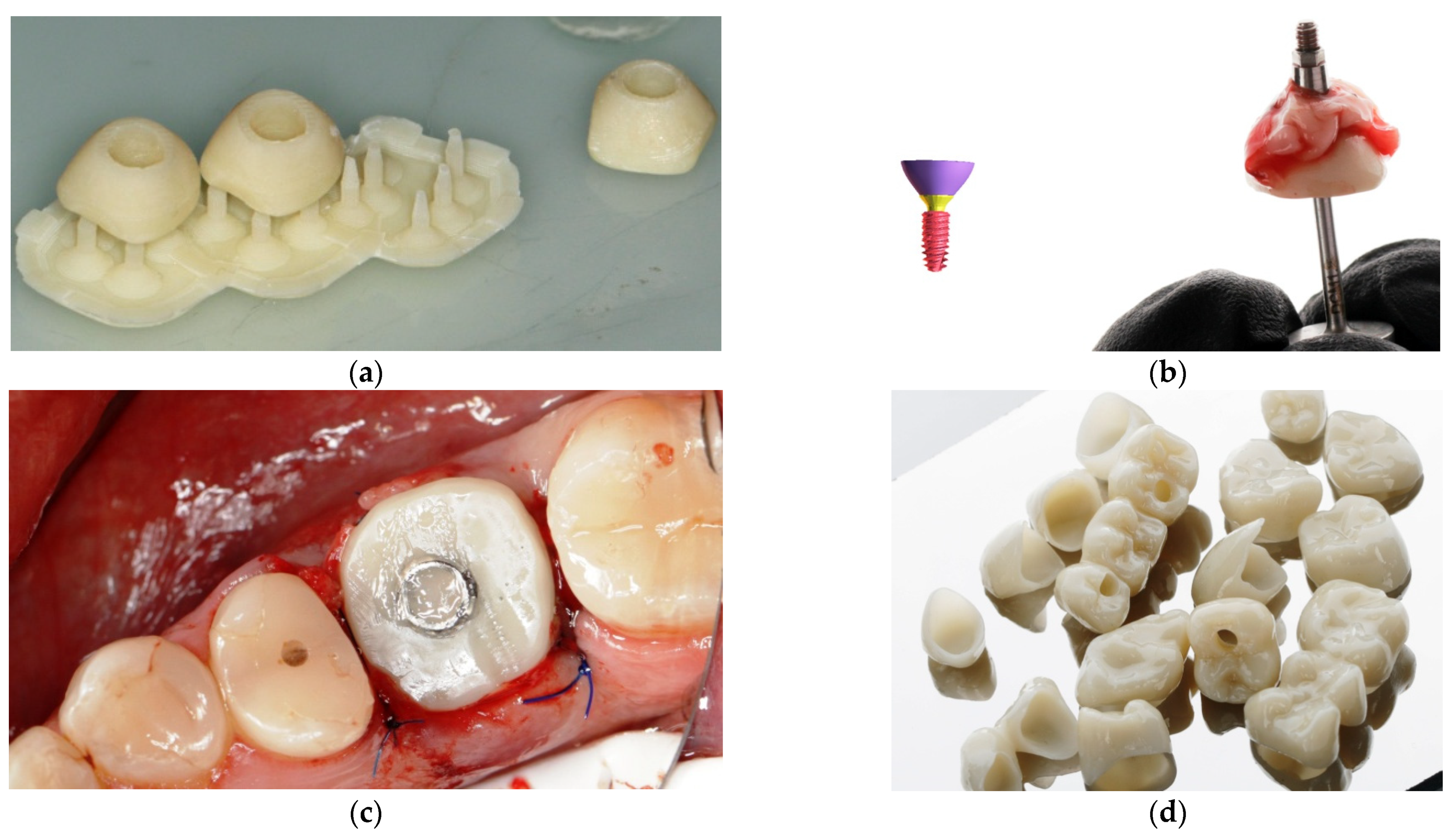




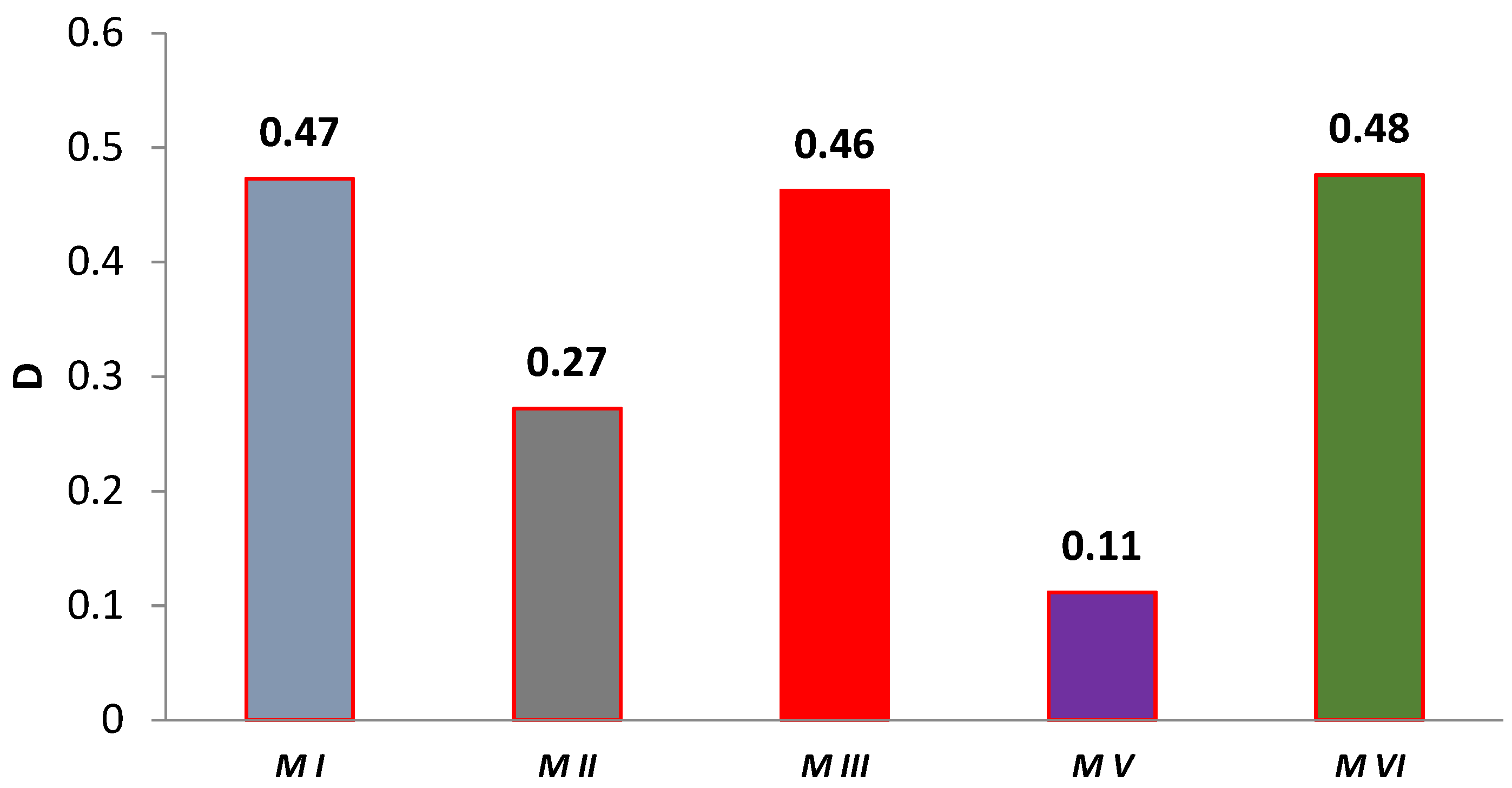
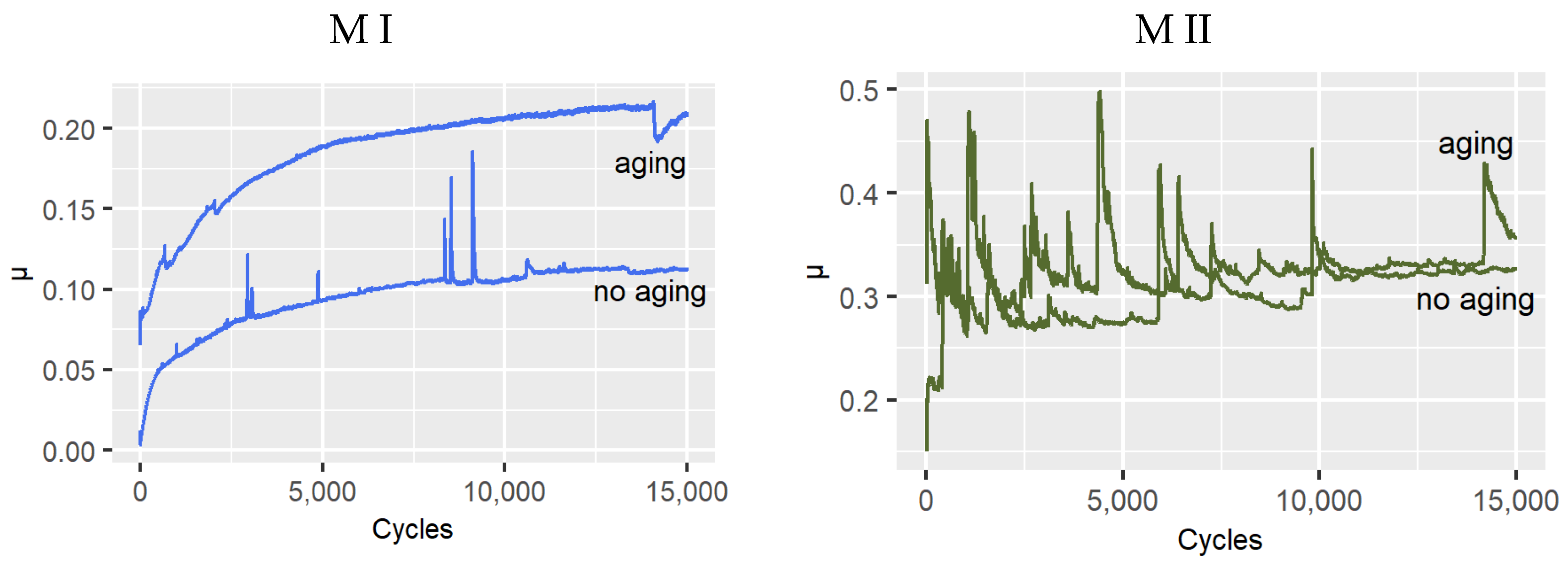

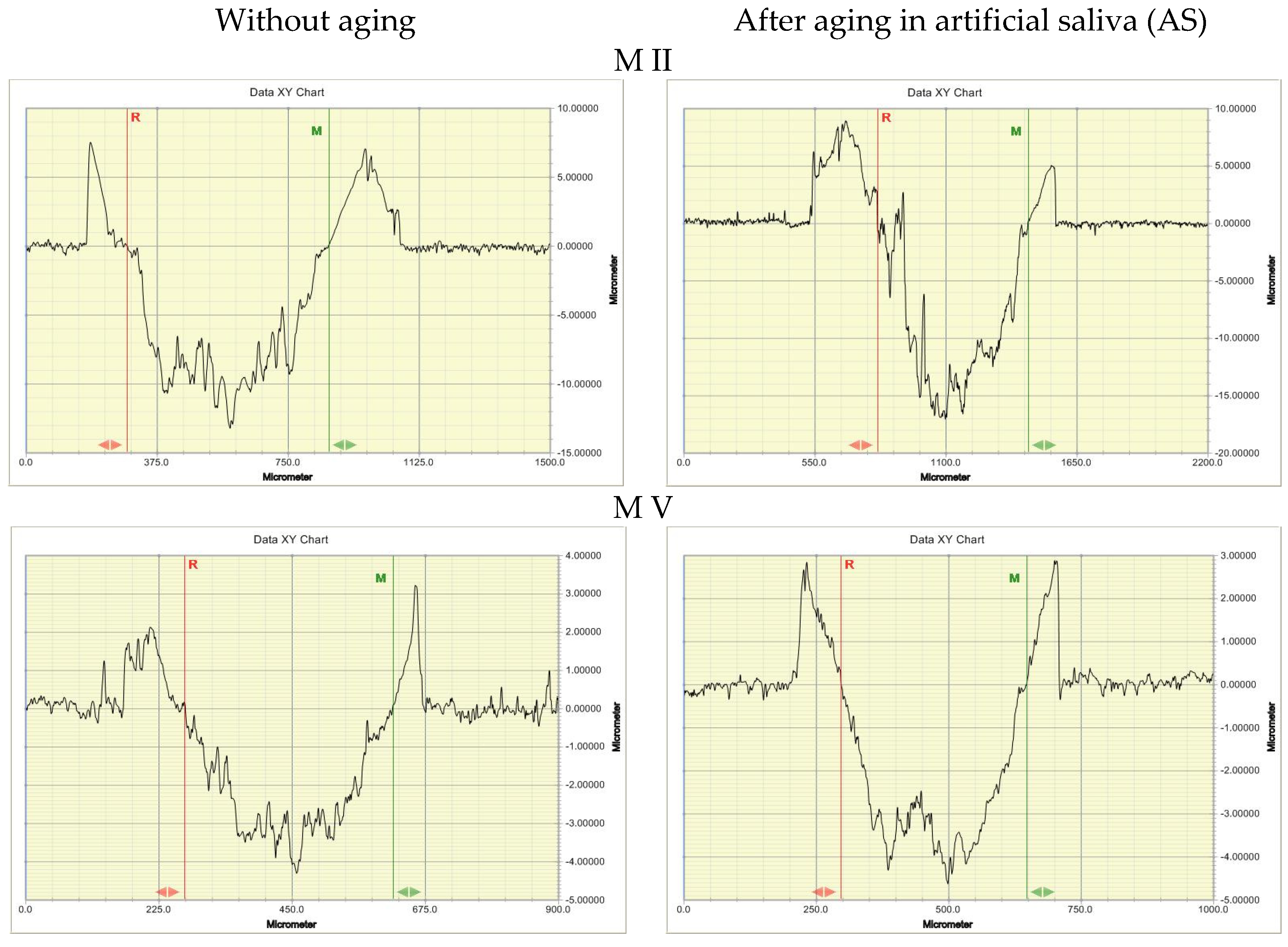
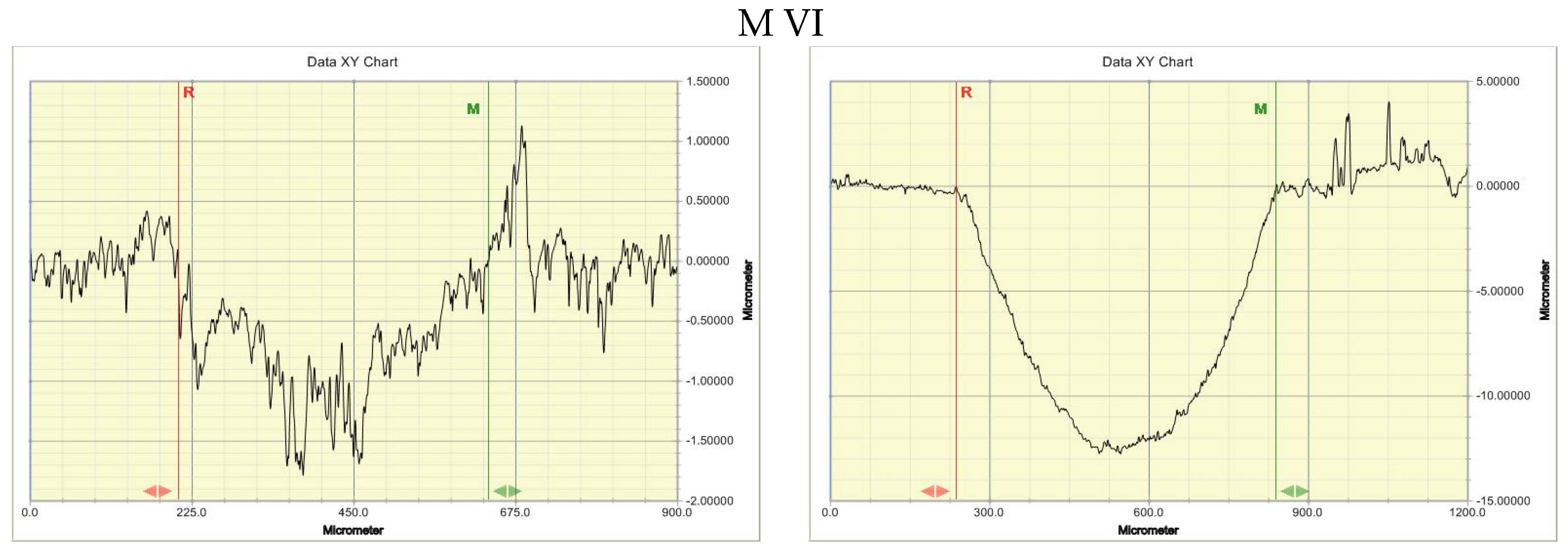
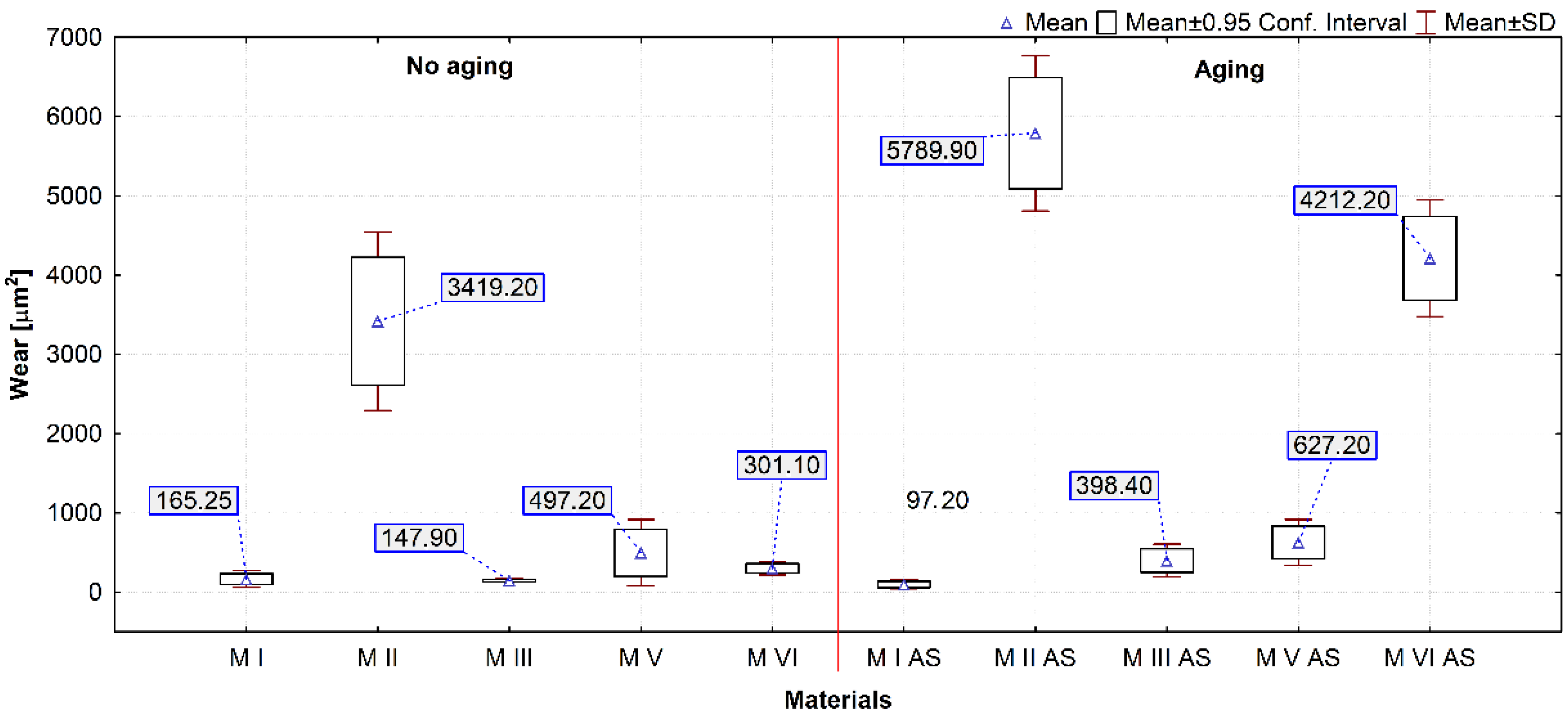
| Material Brand | Producer | Name of Material in the Article | Printer | Chemical Composition | Concentration [% w/w] |
|---|---|---|---|---|---|
| Gr-17.1 temporary It | Pro3dure | M I | ASIGA UV MAX | 7,7,9(or 7,9,9)-trimethyl-4,13-dioxo-3,14-dioxa-5,12-diazahexadecane-1,16-diyl bismethacrylate | 20–50 |
| 3,6,9-trioxaundecamethylene Dimethacrylate | 10–25 | ||||
| Phenyl bis(2,4,6-trimethylbenzoyl)-phosphine oxide | <50 | ||||
| Silicon dioxide | <2 | ||||
| GR-10 guide | Pro3dure | M II | ASIGA UV MAX | Phenyl bis(2,4,6-trimethylbenzoyl)-phosphine oxide | ≤2 |
| Esterification products: of 4,4′-isopropylidenediphenol, ethoxylated and 2-methylprop-2-enoic acid | ≥95 | ||||
| GR-17 temporary | Pro3dure | M III | ASIGA UV MAX | 7,7,9(or 7,9,9)-trimethyl-4,13-dioxo-3,14-dioxa-5,12-diazahexadecane-1,16-diyl bismethacrylate | 20–50 |
| 3,6,9-trioxaundecamethylene Dimethacrylate | 10–25 | ||||
| Phenyl bis(2,4,6-trimethylbenzoyl)-phosphine oxide | <50 | ||||
| Silicon dioxide | <2 | ||||
| NextDent SG Orange | NextDent | M V | Phrozen Shuffle Lite 3D | Ethoxylated bisphenol A dimethacrylate | ≥75 |
| 7,7,9(or 7,9,9)-trimethyl-4,13-dioxo-3,14-dioxa-5,12-diazahexadecane-1,16-diyl bismethacrylate | 30–50 | ||||
| Phenyl bis (2,4,6-trimethylbenzoyl)-phosphine oxide | <10 | ||||
| NextDent C & B MFH | NextDent | M VI | Phrozen Shuffle Lite 3D | 7,7,9(or 7,9,9)-trimethyl-4,13-dioxo-3,14-dioxa-5,12-diazahexadecane-1,16-diyl bismethacrylate | 50–75 |
| 2-hydroxyethyl methacrylate | <25 | ||||
| Silicon dioxide | 1–5 | ||||
| diphenyl(2,4,6-trimethylbenzoyl)phosphine oxide | 1–5 | ||||
| Ethoxylated bisphenol A dimethacrylate | <10 | ||||
| ethylene dimethacrylate | <10 | ||||
| Titanium dioxide | <0.1 | ||||
| Mequinol; 4-methoxyphenol; hydroquinone monomethyl ether | <0.1 |
| No. | Factory Software Parameters | Heater Temperature [°C] | Light Intensity | Burn-In Layers | Burn-In Exposure |
|---|---|---|---|---|---|
| 1 | Gr-17.1 LT (pro3dure) | 40 | 6 | 1 | 0.5 |
| 2 | GR-17 (pro3dure) | 30 | 6 | 1 | 0.5 |
| 3 | GR-10 guide (pro3dure) | 30 | 6 | 1 | 0.5 |
| No. | Material | Color | Layer Thickness [mm] | Lowering Speed | Delay [ms] |
|---|---|---|---|---|---|
| 1 | NextDent SG Orange | Orange | 0.1 | 100 | 1000 |
| 2 | NextDent C & B MFH | N1 | 0.05 | 100 | 1000 |
| Lower layers | |||||
| No. | Material | Number of layers | Exposure time [ms] | Height [mm] | Lifting speed |
| 1 | NextDent SG Orange | 6 | 30,000 | 10 | 80 |
| 2 | NextDent C & B MFH | 8 | 40,000 | 6 | 80 |
| Normal layers | |||||
| No. | Material | Exposure time [ms] | Height [mm] | Lifting speed | |
| 1 | NextDent SG Orange | 13,500 | 9 | 100 | |
| 2 | NextDent C & B MFH | 15,000 | 4 | 100 | |
| No. | Factory Software Parameters | Rinsing in Isopropyl Alcohol (min) | Post-Curing (min) |
|---|---|---|---|
| 1 | Gr-17.1 LT (pro3dure) | 4.5 | 10 |
| 2 | GR-17 (pro3dure) | 4.5 | 10 |
| 3 | GR-10 guide (pro3dure) | 4.5 | 10 |
| No. | Material | Color | Rinsing in Isopropylalcohol (min) | Post-Curing (min) |
|---|---|---|---|---|
| 1 | NextDent SG Orange | Orange | 4.5 | 20 |
| 2 | NextDent C & B MFH | N1 | 4.5 | 20 |
| (a) Descriptive Statistics of Indentation Hardness, Stiffness and Indentation Modulus of the Surface of the Tested Materials—Materials without Aging | ||||||
| Mechanical Size | Statistical Parameter | Materials without Aging | ||||
| M I | M II | M III | M V | M VI | ||
| N (no. of. specim.) = 5 | n (no. of. obs.) | 25 | 25 | 25 | 25 | 25 |
| HIT (O & P) [MPa] | Mean | 78.414 | 84.475 | 81.767 | 254.001 | 116.568 |
| Std Dev | 1.437 | 1.445 | 1.795 | 21.086 | 5.63 | |
| Min. | 76.06 | 80.087 | 77.102 | 211.728 | 107.606 | |
| Max. | 81.377 | 86.927 | 85.799 | 289.394 | 129.209 | |
| Median | 78.207 | 84.652 | 82.169 | 249.701 | 116.89 | |
| Shape (Weibull) | 61.572 | 67.557 | 52.147 | 13.893 | 23.579 | |
| Scale (Weibull) | 79.104 | 85.153 | 82.614 | 263.37 | 119.18 | |
| S (O & P) [mN/μm] | Mean | 383.728 | 315.936 | 372.101 | 420.71 | 1170.405 |
| Std Dev | 4.023 | 2.557 | 1.971 | 3.103 | 126.55 | |
| Min. | 374.736 | 311.198 | 368.443 | 414.862 | 682.258 | |
| Max. | 390.423 | 320.156 | 377.42 | 426.686 | 1394.335 | |
| Median | 384.018 | 315.211 | 371.749 | 420.5 | 1183.031 | |
| EIT (O & P) [GPa] | Mean | 1.918 | 1.639 | 1.899 | 3.788 | 7.16 |
| Std Dev | 0.033 | 0.023 | 0.027 | 0.172 | 0.757 | |
| Min. | 1.87 | 1.585 | 1.825 | 3.433 | 4.21 | |
| Max. | 1.989 | 1.672 | 1.953 | 4.088 | 8.57 | |
| Median | 1.911 | 1.638 | 1.9 | 3.742 | 7.229 | |
| E* (O & P) [GPa] | Mean | 2.108 | 1.801 | 2.086 | 4.163 | 7.868 |
| Std Dev | 0.036 | 0.025 | 0.03 | 0.189 | 0.832 | |
| Min. | 2.055 | 1.742 | 2.006 | 3.772 | 4.627 | |
| Max. | 2.185 | 1.838 | 2.146 | 4.492 | 9.417 | |
| Median | 2.1 | 1.8 | 2.088 | 4.113 | 7.944 | |
| (b) Descriptive statistics of indentation hardness, stiffness and indentation modulus of the surface of the tested materials—materials after aging | ||||||
| Mechanical size | Statistical parameter | Materials after aging | ||||
| M I AS | M II AS | M III AS | M V AS | M VI AS | ||
| N (no. of. specim.) = 5 | n (no. of. obs.) | 25 | 25 | 25 | 25 | 25 |
| HIT (O & P) [MPa] | Mean | 51.565 | 67.722 | 50.664 | 219.804 | 189.726 |
| Std Dev | 2.864 | 3.767 | 2.024 | 5.56 | 6.904 | |
| Min. | 46.261 | 60.433 | 46.551 | 207.193 | 178.742 | |
| Max. | 55.124 | 72.87 | 54.427 | 228.273 | 203.9 | |
| Median | 52.154 | 68.128 | 50.89 | 219.878 | 188.594 | |
| Shape (Weibull) | 20.454 | 20.66 | 29.162 | 46.17 | 31.090 | |
| Scale (Weibull) | 52.889 | 69.442 | 51.588 | 222.37 | 192.99 | |
| S (O & P) [mN/μm] | Mean | 249.884 | 256.947 | 254.125 | 401.786 | 481.595 |
| Std Dev | 2.7 | 5.212 | 2.931 | 5.267 | 5.916 | |
| Min. | 245.445 | 244.751 | 248.441 | 393.725 | 472.935 | |
| Max. | 254.98 | 263.548 | 260.178 | 410.869 | 489.864 | |
| Median | 249.783 | 257.835 | 253.171 | 401.018 | 483.139 | |
| EIT (O & P) [GPa] | Mean | 1.011 | 1.193 | 1.02 | 3.366 | 3.75 |
| Std Dev | 0.038 | 0.056 | 0.031 | 0.07 | 0.11 | |
| Min. | 0.941 | 1.073 | 0.956 | 3.208 | 3.602 | |
| Max. | 1.067 | 1.268 | 1.07 | 3.48 | 3.956 | |
| Median | 1.025 | 1.199 | 1.014 | 3.365 | 3.753 | |
| E* (O & P) [GPa] | Mean | 1.112 | 1.311 | 1.121 | 3.698 | 4.121 |
| Std Dev | 0.042 | 0.062 | 0.034 | 0.077 | 0.121 | |
| Min. | 1.034 | 1.179 | 1.05 | 3.526 | 3.958 | |
| Max. | 1.173 | 1.394 | 1.175 | 3.824 | 4.348 | |
| Median | 1.126 | 1.318 | 1.114 | 3.698 | 4.124 | |
| Materials | Max. Hertzian Contact Stress [GPa] | Archard’s Wear Coefficient K [mm2/N] | Specific Wear Rate k [mm3/Nm] |
|---|---|---|---|
| No aging | |||
| M I | 8.46 · 10−2 | 2.59 · 10−7 | 3.3 · 10−6 |
| M II | 7.61 · 10−2 | 5.77 · 10−6 | 6.83 · 10−5 |
| M III | 8.403 · 10−2 | 2.42 · 10−7 | 2.96 · 10−6 |
| M V | 1.291 · 10−1 | 2.52 · 10−6 | 9.94 · 10−6 |
| M VI | 1.324 · 10−1 | 7.02 · 10−7 | 6.02 · 10−6 |
| After aging | |||
| M I AS | 6.16 · 10−2 | 1.00 · 10−7 | 1.94 · 10−6 |
| M II AS | 2.012 · 10−1 | 7.84 · 10−6 | 1.16 · 10−4 |
| M III AS | 5.521 · 10−2 | 4.03 · 10−7 | 7.96 · 10−6 |
| M V AS | 1.226 · 10−1 | 2.76 · 10−6 | 1.25 · 10−5 |
| M VI AS | 1.316 · 10−1 | 1.60 · 10−5 | 8.42 · 10−5 |
Publisher’s Note: MDPI stays neutral with regard to jurisdictional claims in published maps and institutional affiliations. |
© 2021 by the authors. Licensee MDPI, Basel, Switzerland. This article is an open access article distributed under the terms and conditions of the Creative Commons Attribution (CC BY) license (https://creativecommons.org/licenses/by/4.0/).
Share and Cite
Firlej, M.; Pieniak, D.; Niewczas, A.M.; Walczak, A.; Domagała, I.; Borucka, A.; Przystupa, K.; Igielska-Kalwat, J.; Jarosz, W.; Biedziak, B. Effect of Artificial Aging on Mechanical and Tribological Properties of CAD/CAM Composite Materials Used in Dentistry. Materials 2021, 14, 4678. https://doi.org/10.3390/ma14164678
Firlej M, Pieniak D, Niewczas AM, Walczak A, Domagała I, Borucka A, Przystupa K, Igielska-Kalwat J, Jarosz W, Biedziak B. Effect of Artificial Aging on Mechanical and Tribological Properties of CAD/CAM Composite Materials Used in Dentistry. Materials. 2021; 14(16):4678. https://doi.org/10.3390/ma14164678
Chicago/Turabian StyleFirlej, Marcel, Daniel Pieniak, Agata M. Niewczas, Agata Walczak, Ivo Domagała, Anna Borucka, Krzysztof Przystupa, Joanna Igielska-Kalwat, Wojciech Jarosz, and Barbara Biedziak. 2021. "Effect of Artificial Aging on Mechanical and Tribological Properties of CAD/CAM Composite Materials Used in Dentistry" Materials 14, no. 16: 4678. https://doi.org/10.3390/ma14164678
APA StyleFirlej, M., Pieniak, D., Niewczas, A. M., Walczak, A., Domagała, I., Borucka, A., Przystupa, K., Igielska-Kalwat, J., Jarosz, W., & Biedziak, B. (2021). Effect of Artificial Aging on Mechanical and Tribological Properties of CAD/CAM Composite Materials Used in Dentistry. Materials, 14(16), 4678. https://doi.org/10.3390/ma14164678








